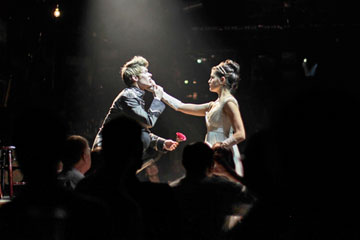
In the Immersive play Natasha, Pierre and the Great Commet of 1812, the audience gets dinner with a twist: actors weave through the crowd and get up close and personal.
Making a musical out of War and Peace might seem like a fool's errand. All those pages. All those subplots. All those Russian names. Natasha, Pierre and the Great Comet of 1812, Dave Malloy's cheeky pop-rock version of (at least a portion of) Tolstoy's novel, helps out on the name front with a cute opening number that introduces the characters with primer-like directness ("Helene's a slut, Anatole's hot, Sonya's good ..."). The show gets playgoers into the mood by seating them at tables in a faux Russian supper club and feeding them borscht and blini. And it scatters the action everywhere: on ribbonlike stages that snake through the club, in the aisles, even right at your table.
Immersive theater is suddenly the rage, and no passive theatergoer is safe. Along with Natasha, Pierre (housed in a Manhattan tent), Here Lies Love, David Byrne's terrific new musical about Imelda Marcos, is staged on a disco floor, with the audience herded about to make way for constantly morphing stages. In Then She Fell, an enchanting interactive show inspired by Alice's Adventures in Wonderland, just 15 audience members are led through three floors of a Brooklyn building, given potions to drink, invited to tea and generally ordered about by a band of Lewis Carroll characters. Meanwhile, Sleep No More, from London's Punchdrunk theater company, is still going strong after two years, inviting guests to wander the elaborately appointed rooms of a decrepit Chelsea hotel, stumbling on actors miming Macbeth.
Even stodgy Broadway is having more interactive fun with the folks in the orchestra seats. Some shows, like last year's Tony-winning musical Once and this spring's The Testament of Mary, invite patrons onstage before the opening curtain--to explore the set, soak up the ambience and maybe belly up to the bar. Others, like Bette Midler's I'll Eat You Last and last season's One Man, Two Guvnors, pull audience members onstage for some (purportedly) unscripted repartee.
Across the U.S., meanwhile, regional companies are experimenting with site-specific shows that get audiences out of the theater and into the action. So far this spring there have been plays staged in an Ikea store (Theater 4 in New Haven, Conn.) and a lingerie shop (Fishtank Theater in Kansas City, Mo.), and St. Louis' OnSite Theatre is about to open one in a laundromat. In October, San Diego's La Jolla Playhouse will present a whole weekend of site-specific shows in its Without Walls festival. Among the highlights: We Built This City, in which audience members build a model city out of cardboard boxes, and The Car Plays, a series of 15 two-character playlets, staged in 15 different cars and viewed by two audience members at a time, rotating from car to car.
These immersive shows are "redefining the relationship between the audience and the theater," says La Jolla Playhouse artistic director Christopher Ashley. They're also making theatergoing more of an event--a unique live experience that simply can't be duplicated on the movie screen or the computer. It's no accident that the immersive movement is happening at a time when nearly every other popular art form--movies, recorded music, TV--is battling for survival against the Internet. One thing the Web can never replace is the live-theater experience, something immersive shows underscore vividly.
